Hussian Z., AbdullahM.Z., AlimuddinZ. Basic Fluid Mechanics and Hydraulic Machines
Подождите немного. Документ загружается.


"This page is Intentionally Left Blank"

Thermal and Hydropower Plants
61
3.1 Introduction
Electrical energy
is
the cleanest form
of
energy used
in
household appl iances, street lighting,
and
in
small and large industries. Energy is avai lable
in
various forms and can be converted
from one form
to
another. Electrical energy
is
produced
in
large power houses and
is
transmitted to users by cables.
The
more a country is developed the more the energy utilised
by the people for good living.
In
fact the criteria for a developed nation is how Illuch energy
is being used by each person and that is the gauge
of
development
of
the country.
If
the
energy needs are satisfied one can enjoy a comfortable life. Every effort
is
being made by
engineers, research organisations and power plant producers to produce cheap
ele<.:tri<.:al
energy.
In
thermal power plants the fossil fuel generally used
is
coal, oil
or
gas.
In
hydro
power
plants the source is water.
The
countries which have large reserves
of
fossi I fuel are
in
a better way to solve energy-related problems than countries which lack these reserves.
The
countries which have large oil reserves are Iran, Iraq, Saudi Arabia, Russia, USA and
the countries which lack oil reserves are
India, Japan, UK and some African nations. But
the oil can be transported by pipelines from one country to another travelling some thousands
of
kilometers,
or
through pipelins under the sea,
or
by huge shipliners. Oil production
is
generally rated
in
barrels and each barrel
is
about 160 I itres. Oil-producing countries produce
several millions
of
barrel per day that is why oil
is
sometimes called 'Black Gold'. Crude oil
is obtained by boring oil wells underground
or
under the sea bed. Coal
is
another source
of
fuel used in power plants.
It
is used in crushed
or
powder form (pulverised). Coal
is
obtained
from coal mines, located several hundred meters below the surface
of
the earth.
It
has to be
chemically treated before it can be used
in
power
plants. Coal contains some percentage
of
ash about i.e., 3 to 10%. Ash removal is a big problem. Some varieties
of
coal found
in
India
contain as much as
40%
ash still being used as fuel.
The
coal-fired power plants has low
thermal efficiency than oil-fired plants, as heating value
of
coal is generally 30-35 MJ/kg
compared to oil which is about 45-48 MJ/kg. Moreover, oil is used
in
vapour form which
mixes readily with the molecules
of
airgiving
high rate
of
combustion than coal.
Gas
is
perhaps the ideal fuel to be used in thermal
power
plants.
It
is clean, efficient and available
in gaseous state as air. So
one
can
expect
efficient combustion.
The
plants also have high
thermal efficiency.
The
cheapest
way
to
produce electrical energy is by hydropower plants. First, water
does
not
require
any
treatment as applied to fuels. It is abundant and free.
The
only criteria
is
water
must have a fall from a height
or
create head, as
it
is
called, and be available
in
large
quantities for power generation. Dams are constructed across the river to store water.
The
water is conveyed to the turbines by penstock which convert hydraulic energy to mechanical
energy. Electrical generators convert it to electrical energy. India has large number
of
hydropower stations which produce thousands
of
kilowatts. Another advantage
of
hydropower
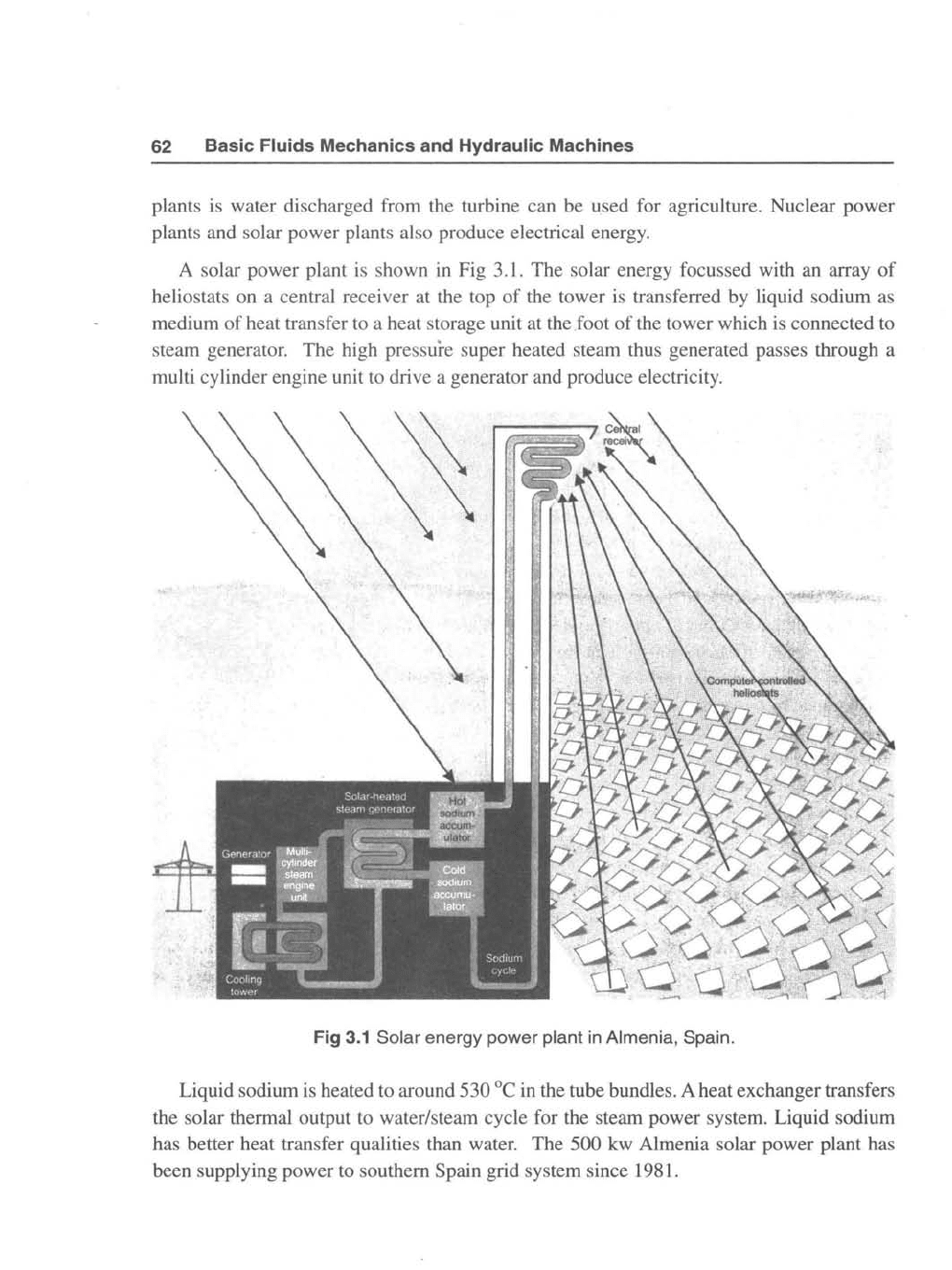
62
Basic Fluids Mechanics and Hydraulic Machines
plants is water discharged from the turbine can be used for agriculture. Nuclear power
plants and solar power plants also produce electrical energy.
A solar power plant
is
shown
in
Fig 3.1. The solar energy focussed with an array
of
heliostats on a central receiver at the top
of
the tower
is
transferred by liquid sodium as
medium
of
heat transfer to a heat storage unit at the foot
of
the tower which
is
connected to
steam generator. The high pressure super heated steam thus generated passes through a
multi cylinder engine unit to drive a generator and produce electricity.
Fig
3.1
Solar energy power plant in Almenia, Spain.
Liquid sodium is heated to around
530°C
in the tube bundles. A heat exchanger transfers
the solar thermal output to water/steam cycle for the steam power system. Liquid sodium
has better heat transfer qualities than water. The
500 kw Almenia solar power plant has
been supplying power to southern Spain grid system since 1981.
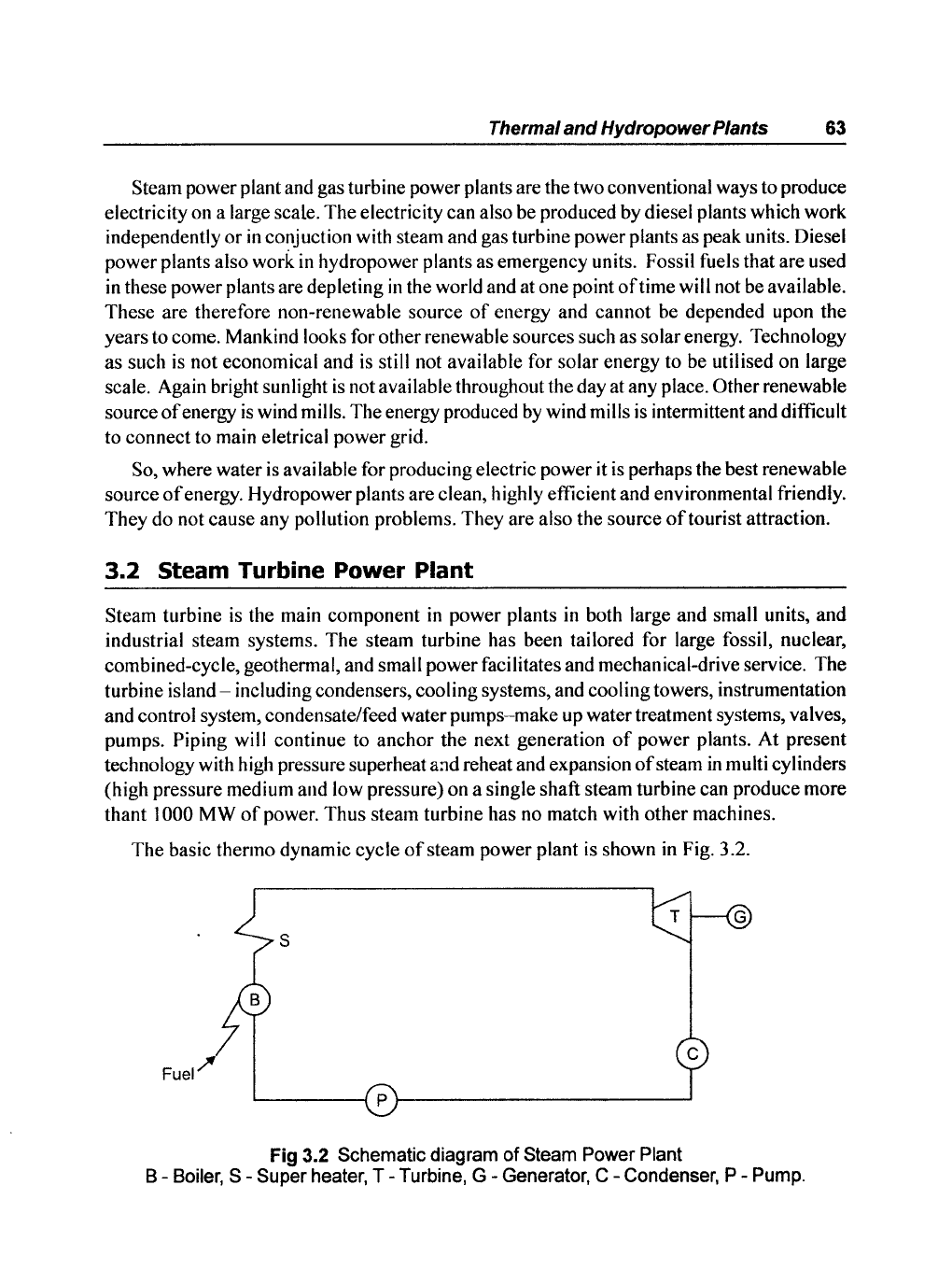
Thermal and Hydropower Plants
63
Steam power plant and gas turbine power plants are the two conventional ways to produce
electricity on a large scale. The electricity can also be produced by diesel plants which work
independently
or
in
conjuction with steam and gas turbine power plants as peak units. Diesel
power plants also
work
in
hydropower plants as emergency units. Fossil fuels that are used
in these power plants are depleting
in
the world and at one point
of
time will not be available.
These are therefore non-renewable source
of
energy and cannot be depended upon the
years to come. Mankind looks for other renewable sources such as solar energy. Technology
as such is not economical and is still not available for solar energy to be utilised on large
scale. Again bright sunlight
is
not avai lable throughout the day at any place. Other renewable
source
of
energy
is
wind mills. The energy produced by wind mills is intermittent and difficult
to connect to main eletrical power grid.
So, where water is avai lable for producing electric power it is perhaps the best renewable
source
of
energy. Hydropower plants are clean, highly efficient and environmental friendly.
They do not cause any pollution problems. They are also the source
oftourist
attraction.
3.2 Steam Turbine Power Plant
Steam turbine is the main component
in
power plants
in
both large and small units, and
industrial steam systems. The steam turbine has been tailored for large fossil, nuclear,
combined-cycle, geothermal, and small power facilitates and mechanical-drive service. The
turbine island - including condensers, cooling systems, and cooling towers, instrumentation
and control system, condensate/feed water pumps-make up water treatment systems, valves,
pumps.
Piping will continue to anchor the next generation
of
power plants. At present
technology with high pressure superheat
a:1d
reheat and expansion
of
steam
in
multi cylinders
(high pressure medium and low pressure) on a single shaft steam turbine can produce more
thant
1000 MW
of
power. Thus steam turbine has no match with other machines.
The
basic thermo dynamic cycle
of
steam power plant is shown in Fig. 3.2.
s
Fuel)"
~------~
p
~----------------------~
Fig 3.2 Schematic diagram
of
Steam Power Plant
B - Boiler,
S - Super heater, T - Turbine, G - Generator, C - Condenser, P - Pump.
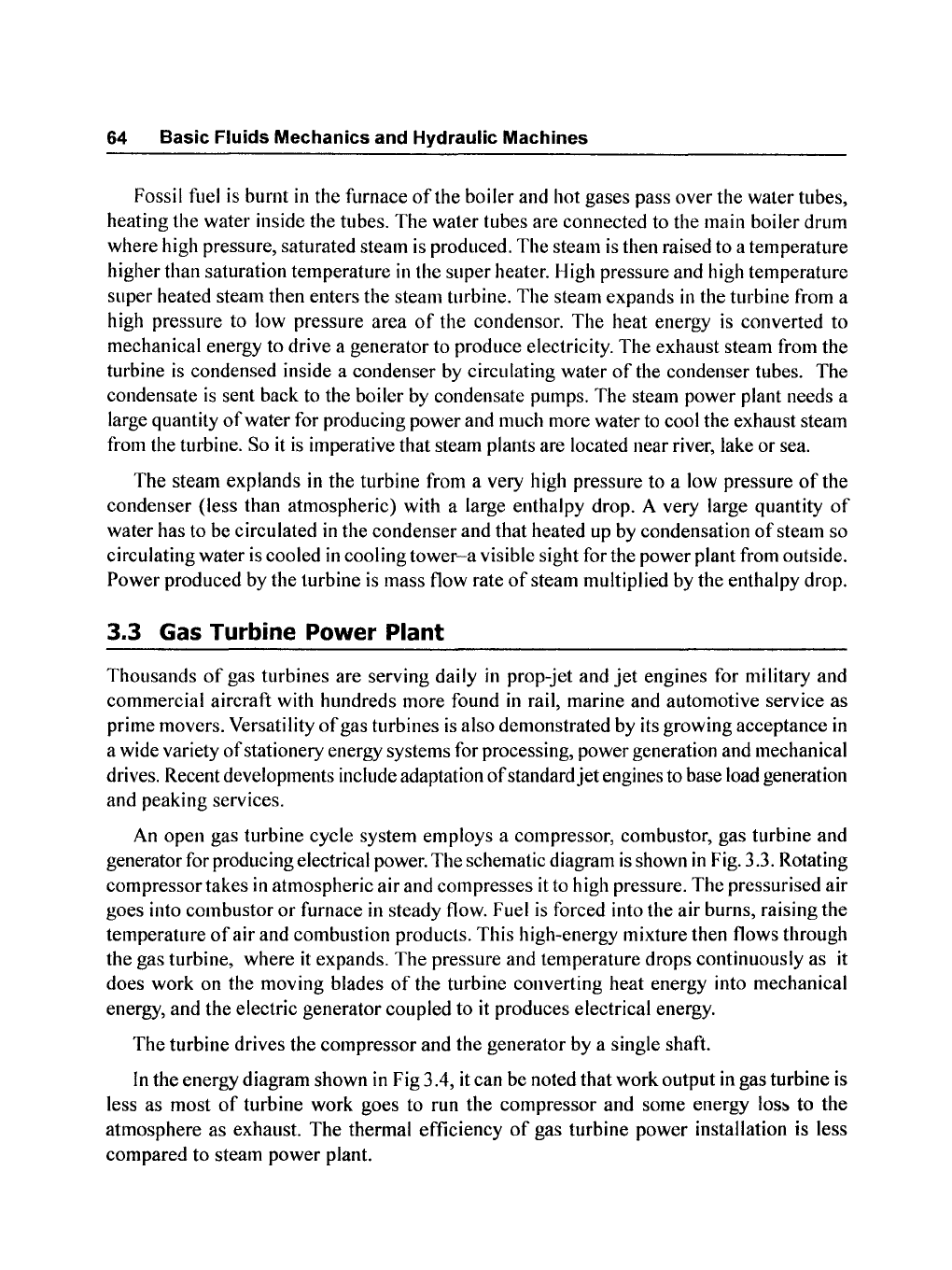
64 Basic Fluids Mechanics and Hydraulic Machines
Fossil fuel
is
burnt
in
the furnace
of
the boiler and hot gases pass over the water tubes,
heating the water inside the tubes. The water tubes are connected to the main boiler drum
where high pressure, saturated steam is produced. The steam is then raised to a temperature
higher than saturation temperature
in
the super heater. High pressure and high temperature
super heated steam then enters the steam turbine. The steam expands
in
the turbine from a
high pressure to low pressure area
of
the condensor. The heat energy
is
converted to
mechanical energy to drive a generator to produce electricity. The exhaust steam from the
turbine
is
condensed inside a condenser by circulating water
of
the condenser tubes. The
condensate
is
sent back to the boiler by condensate pumps. The steam power plant needs a
large quantity
of
water for producing power and much more water to cool the exhaust steam
from the turbine. So it
is
imperative that steam plants are located near river, lake or sea.
The
steam explands in the turbine from a very high pressure to a low pressure
of
the
condenser (less than atmospheric) with a large enthalpy drop. A very large quantity
of
water has to be circulated
in
the condenser and that heated up by condensation
of
steam so
circulating water is cooled
in
cooling
tower-a
visible sight for the power plant from outside.
Power produced by the turbine is mass flow rate
of
steam multiplied by the enthalpy drop.
3.3
Gas
Turbine Power Plant
Thousands
of
gas turbines are serving daily
in
prop-jet and
jet
engines for military and
commercial aircraft with hundreds more found
in
rail, marine and automotive service as
prime movers. Versatility
of
gas turbines
is
also demonstrated by its growing acceptance
in
a wide variety
of
stationery energy systems for processing, power generation and mechanical
drives. Recent developments include adaptation
of
standard
jet
engines to base load generation
and peaking services.
An
open gas turbine cycle system employs a compressor, combustor, gas turbine and
generator for producing electrical power. The schematic diagram
is
shown
in
Fig. 3.3. Rotating
compressor takes
in
atmospheric air and compresses it to high pressure. The pressurised air
goes into combustor
or
furnace in steady flow. Fuel is forced into the air burns, raising the
temperature
of
air and combustion products. This high-energy mixture then flows through
the gas turbine, where it expands. The pressure and temperature drops continuously as it
does work on the moving blades
of
the turbine converting heat energy into mechanical
energy, and the electric generator coupled to it produces electrical energy.
The
turbine drives the compressor and the generator by a single shaft.
In
the energy diagram shown
in
Fig 3.4, it can be noted that work output in gas turbine is
less as most
of
turbine work goes to run the compressor and some energy los:, to the
atmosphere as exhaust.
The
thermal efficiency
of
gas turbine power installation is less
compared to steam power plant.

Thermal and Hydropower Plants 65
Fuel
Air
Exhaust
t
Combustor
Compressor
Fig 3.3 A schematic diagram
of
gas tubine power plant.
Air
in
1----
---1
1
1
1
1
1
1
1
1
1
1
'--
______
1
Compressor
Fuel
Combustor
,...--------
-
----,
1
1
1
1
-
1 1
1
______
--
______
1
-
Shaft work
to
compress
Exhaust
1
1
1
1
1
1
1
1
1
1
I
___
__
_ J
Fig.
3.4
Energy diagram
of
gas turbine power plant.

66 Basic Fluids Mechanics and Hydraulic Machines
Fig. 3.5 shows a multistage axial compressor connected by a single shaft to a gas turbine.
Compressor
Fig. 3.5 The compressor and gas turbine mounted on the same shaft.
3.3.1
Comparing Steam and
Gas
Turbine Power Stations
Steam expands in steam turbine from a very high pressure and temperature to low pressure
almost a vacuum in a condensor. Thus there is very large enthalpy drop in the turbine to
produce the work. The gas turbine works at lower pressure but at higher temperature
than steam turbine. The exhaust
of
gas turbine
is
atmospheric. Therefore the enthalpy drop
in gas turbine is less and high temperature gas is exhausted into atmosphere which is
energy loss. The overall efficiency
of
gas turbine power plant is almost half
of
steam power
plant.

Thermal and Hydropower Plants 67
The
steam turbine power plant requires lot
of
water whereas for gas turbine
power
plant
water
is
not a criteria.
It
can be installed even
in
a desert. Time period is a factor
in
steam
power plant for planning, installing and commissioning and
it
takes some years before it is
ready for generating power.
The
gas turbine
power
unit can be installed
in
a few days as compact units are available
only to be connected to chimney. Steam power plant requires a lot
of
land for installing
boi ler, steam turbine, generator, and various other
un
its such as condensing plant, heat recovery
units.
The
gas turbine does not require so much land, and can easily be installed and can be
connected to the grid
in
few minutes after the installation. With the present-day technology
steam turbine can produce about
1000
MW
on a single shaft, whereas gas turbines can
produce
100-150
MW
of
power.
3.4 Combined Cycle Power Plants
Gas
turbine can combine with steam
power
plants to torm combined cycle plants as shown
in
Fig. 3.6. A high-efficiency steam turbine
is
combined thermodynamically to a low-efficiency
gas turbine.
The
high temperature
exhaust
gas from the gas turbine is led into the heat
recovery steam
generator
(HRSG)
thus increasing the mass flow rate
of
gas circulation,
decreasing the fuel
of
the steam unit, developing more power and thus increasing the
Combustion
chamber
2
Fuel
1
3
Compressor
Air
5
4
Heat recovery
steam generator
Gas turbine
Condenser
Steam turbine
Fig. 3.6 A Schematic layout
of
combined cycle power plant.
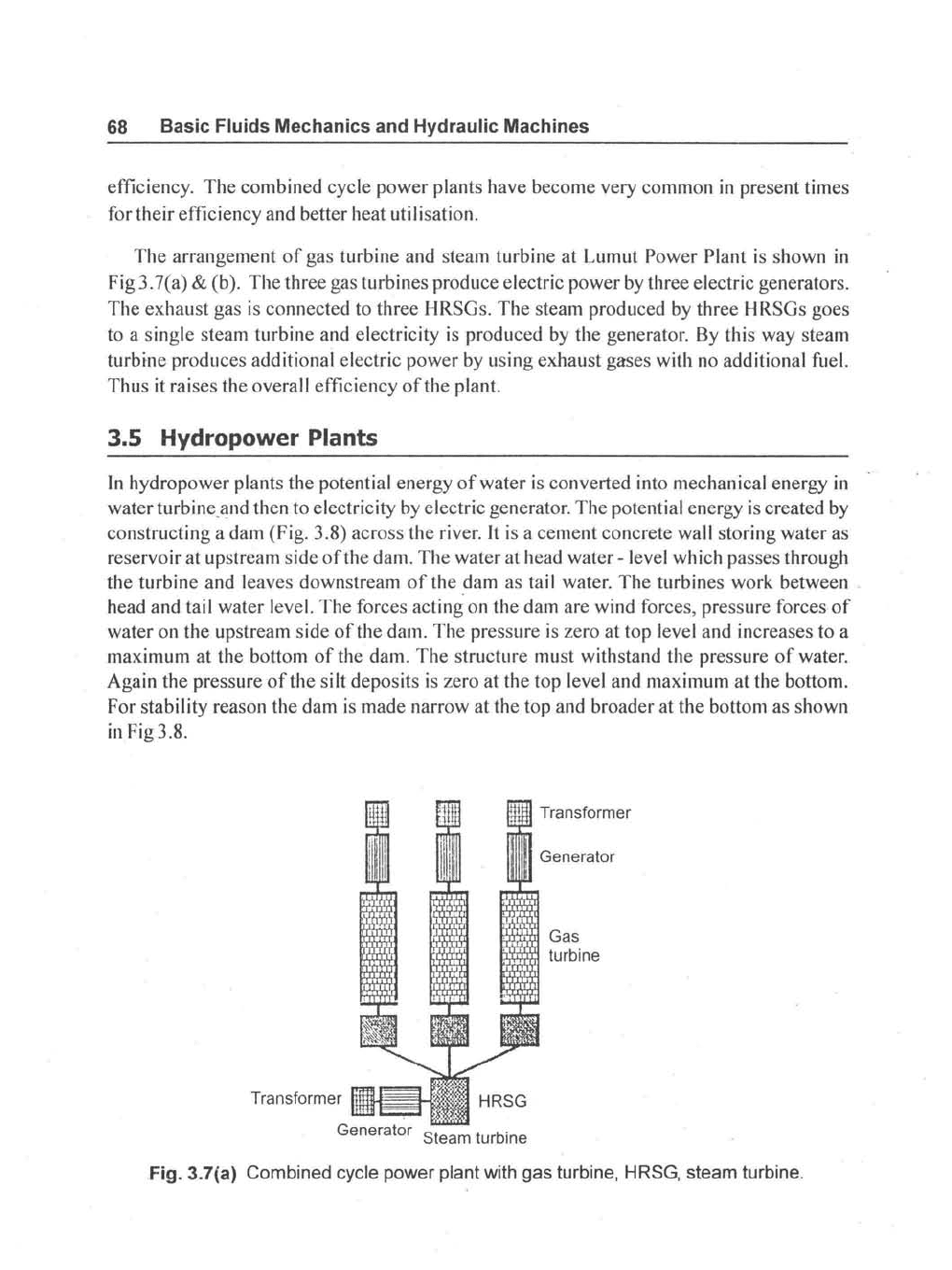
68
Basic Fluids Mechanics and Hydraulic Machines
efficiency. The combined cycle power plants have become very common
in
present times
for their efficiency and better heat utilisation.
The arrangement
of
gas turbine and steam turbine at Lumut Power Plant
is
shown
in
Fig 3.7(a) & (b). The three gas turbines produce electric power by three electric generators.
The exhaust gas
is
connected to three HRSGs. The steam produced
by
three HRSGs goes
to a single steam turbine and electricity is produced
by
the generator.
By
this way steam
turbine produces additional electric power by using exhaust gases with no additional fuel.
Thus it raises the overall efficiency
of
the plant.
3.5 Hydropower Plants
In
hydropower plants the potential energy
of
water
is
converted into mechanical energy
in
water turbine.and then to electricity
by
electric generator. The potential energy is created by
constructing a dam (Fig. 3.8) across the river.
It
is a cement concrete wall storing water as
reservoir at upstream side
of
the dam. The water at head water
-level
which passes through
the turbine and leaves downstream
of
the dam as tail water. The turbines work between .
head and tail water level. The forces acting on the dam are wind forces, pressure forces
of
water on the upstream side
of
the dam. The pressure
is
zero at top level and increases to a
maximum at the bottom
of
the dam.
The
structure must withstand the pressure
of
water.
Again the pressure
ofthe
silt deposits is zero at the top level and maximum at the bottom.
For stability reason the dam
is
made narrow at the top and broader at the bottom as shown
in
Fig3.8.
Transformer
liutl~~t-
Generator Steam turbine
Transformer
Gas
turbine
Fig.3.7(a) Combined cycle power plant with gas turbine, HRSG, steam turbine.
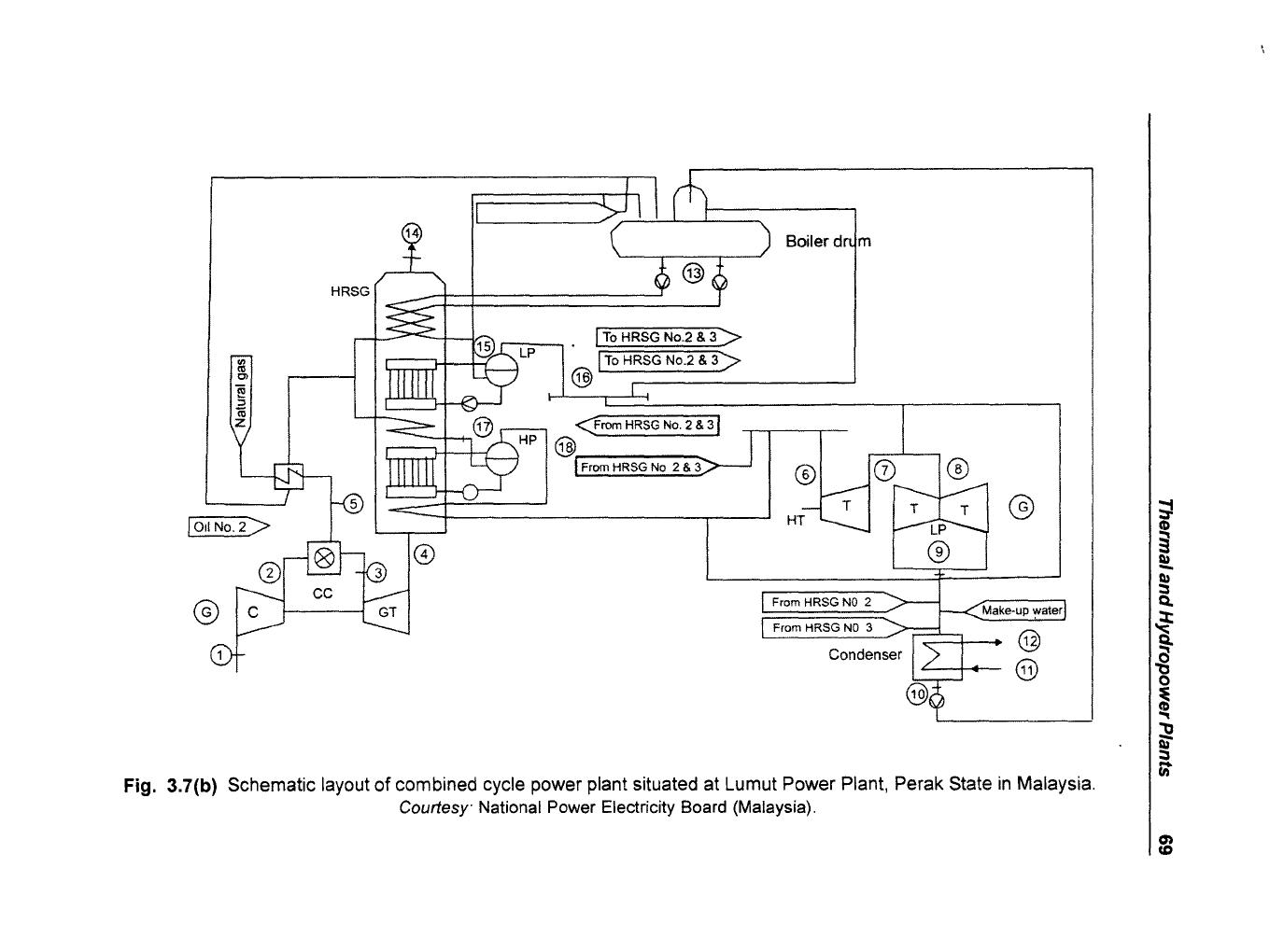
If)
<II
Cl
«from
HRSG
No.2
&
31
@
From HRSG
No
2 & 3
8)
cc
®
C
GT
Boilerd m
®
(])
T
HT
From HRSG
NO
2
From
HRSG
NO
3
®
T
T
LP
®
@
@
Fig. 3.7(b) Schematic layout
of
combined cycle power plant situated at Lumut Power Plant, Perak State
in
Malaysia.
Courtesy' National Power Electricity Board (Malaysia).
